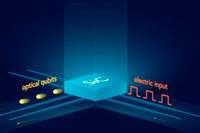 As the race for quantum computing continues, so does the development into quantum technologies targeted to neturalise the threat of hacking.
As the race for quantum computing continues, so does the development into quantum technologies targeted to neturalise the threat of hacking.
Classical cryptographic algorithms are complexity-based and can remain secure only for a certain period of time. Unlike its classical counterpart, quantum cryptography relies on the fundamental laws of physics and is thought to be capable of guaranteeing security of data transmission forever.
The operation principle is based on the fact an unknown quantum state can’t be copied without altering the original message, as a result the quantum communication line can’t be compromised without the sender and the receiver knowing.
Single photons are considered the best carrier for quantum bits. The principal behind this generation is: an excited quantum system can relax into the ground state by emitting exactly one photon.
From an engineering standpoint, a real-world physical system that reliably generates single photons under ambient conditions is required, but this isn’t easy to find.
Researchers from the Moscow Institute of Physics and Technology (MIPT) see a solution in silicon carbide. Through studying the physics of electroluminescence of colour centres in silicon carbide, the team came up with a theory of single-photon emission upon electrical injection that it says explains and accurately reproduces the experimental findings.
A colour centre is a point defect in the lattice structure of silicon carbide that can emit or absorb a photon at a wavelength to which the material is transparent in the absence of defects. This process is at the heart of the electrically driven single-photon source.
The researchers explain that their theory demonstrates how a single-photon emitting diode based on silicon carbide can be improved to emit up to several billion photons per second, which is required to implement quantum cryptography protocols at data transfer rates on the order of 1 Gbps.
New materials are likely to be found which rival silicon carbide in terms of brightness of single-photon emission, add MIPT. But unlike silicon carbide, they will require new technological processes to be used in mass production of devices.
By contrast, silicon carbide-based single-photon sources are compatible with the CMOS technology, which the team say makes it by far the most promising material for building practical ultrawide-bandwidth unconditionally secure data communication lines.
Author
Bethan Grylls
Source: www.newelectronics.co.uk

